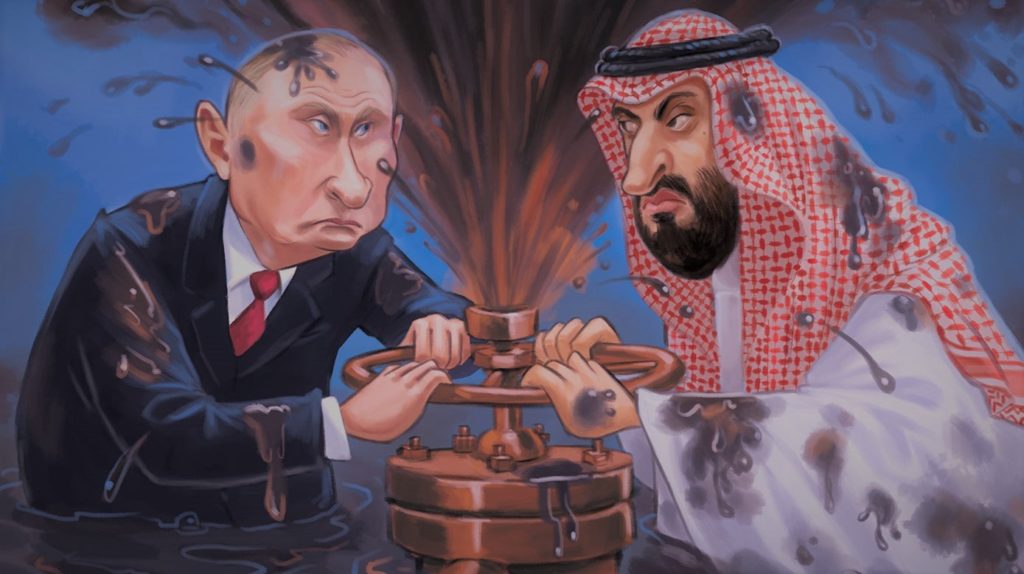At a time when WHO was declaring COVID-19 a global pandemic, the world witnessed dramatic dynamics in oil prices. As the countries around the world underwent into complete lockdown, the demand for oil steeply plummeted. However, low demand was not the sole cause for the oil prices to drop as low as $20 a barrel. When Russia failed to adhere to the pact signed with Saudi Arabia-led OPEC (Organization of Petroleum Exporting Countries) because of its vested interest of acquiring a greater market share, the global oil industry endured an unprecedented chaos. There ensued Saudi – Russia oil war.
Let’s now look at the complete story.
How it started?
Up until 2010, the United States was one of the major petroleum importing countries in the world. However, the rapid growth of private oil shale industries in subsequent years ushered a new fate for the American country. Tables were turned upside down. By 2014, US had become a major competitor for Saudi Arabia and Russia. Though the state protected oil industries in Saudi and Russia retaliated by flooding the market with oil at the reduced price (crashing from more than $114 per barrels in 2014 to around $27 dollars per barrel in 2016), shale industries in US not just managed to survive, but also helped the United States to surpass the both countries as leading producer of crude oil in 2018.
Things were heated since then, but the events took a dramatic turn at the onset of 2020. As the demand for petroleum started to decline, Saudi-led OPEC and Russia signed an agreement to cut down oil production to stabilize the price. However, Russia broke the pact and instead increased the oil production.
There are several speculations surrounding Russia’s motives. The most important being its desire to snatch market share from America by offering oil at low price. Others argued this move to be a retaliation against the sanction imposed by the Trump administration to the largest Russian oil production company, Rosneft, back in February 2020.
How it escalated?
In response to Russia, Saudi Arabia, on March 8 2020, announced an offering of heavy discounts from $6 to $8 dollars per barrel to the customers in Asia, Europe and the United States, as it could not stand Russia enjoying the upper hand in global oil supply chain. The announcement immediately led to the fall of brent crude by 30 %, the largest drop since the Gulf War of 1990/91. Also, the stock market heavily crashed worldwide the following day (March 9). On March 10, Saudi Arabia further announced to increase the oil production from 9.7 million barrels per day to 12.3 million barrels per day. Low demand and high production in a free-market economy led the prices to decline record low. For the first time in history, prices even reached negative at some point, meaning that the producers themselves paid money to evacuate their own warehouses.
How it ended?
As usual, it is when the power comes to play. The United States was heavily affected by the price drop. Most of the oil shale industries in US require a minimum of $40 per barrel for sustained operation. On April 2, US president Donald Trump intervened by threatening to withdraw US military support from Saudi Arabia if OPEC and its allies did not cut down the oil production. He also threatened to impose sanction on Saudi Arabian oil. In response to the statement, US oil prices immediately jumped by almost 25% on the same day, he biggest one day increases in the history!
Saudi Arabia then issued a statement criticizing Russia for not standing the agreement. After the series of video conferences, the two countries finally agreed on April 9 to cut down their production. This marked an end to the month-long dramatic war.
Conclusion
Now, the ultimate question is, did anybody win this war? For Russia and Saudi Arabia—the real players behind the war—it can be called a tie, a loss-loss one. Though they managed to inflict some damage to the US shale industries, they had to accept a heavy loss in their oil-revenues. With the budget deficit expected to increase from 6 % to 9 %, Saudi Arabia had to cut the capital expenditure from $35-40 billion to $25-30 billion. The Russian currency, Ruble, on the other hand fell by more than 30 %. The war, however, had the non-active winners. Huge oil consumer countries like China, South Korea, India, Japan, and so on, largely benefited from the war as they got the crude oil at remarkably low prices.
Was this article helpful?
Mention in the comments section below.
Do not forget to check our research paper summaries, and other general blog posts.







